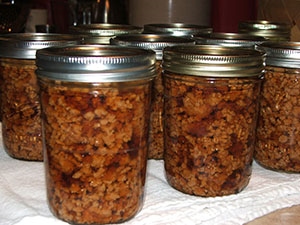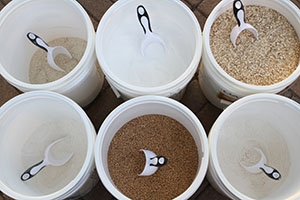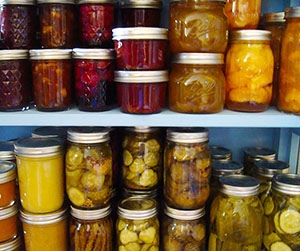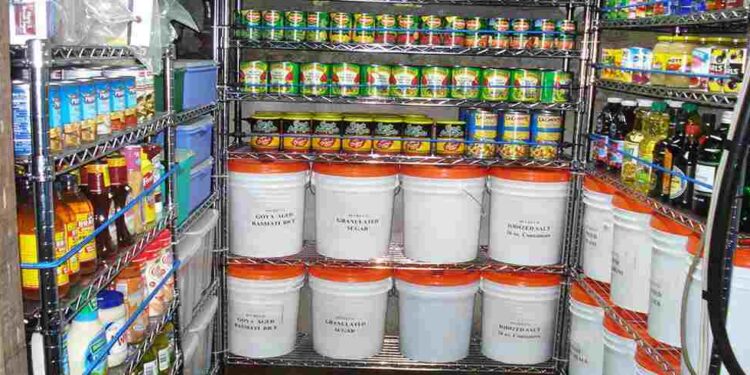Spring always has me thinking about my emergency supplies, especially the first 30-day supply. I live in a hurricane evacuation zone in Florida, so these emergency supplies are vitally important to my planning.
I have experienced what happens when an emergency approaches. The store shelves empty of all foods that don’t require refrigeration, bottled water is the first to go, then stores and restaurants close, lines for gasoline are extremely long until finally the tanks are empty, and no gas is to be had. Most of the emergencies I’ve faced have lasted for only a week or two. But I know that as storms get stronger and man’s evil prevails, it will get worse. I plan for these events so that my family will be protected and, hopefully, comfortable.
My Food Storage Levels of Protection
My first level of protection is my pantry. I usually have two to four weeks of food in the pantry and freezer. These must be used first, especially if power is not restored quickly.
When the pantry foods are finished, I have a short-term supply that requires no refrigeration and is packed to be portable. These are the foods I take with me if evacuation is required because of a hurricane, fire, or other disaster. These are the 30 day supply I am packing away today.
Finally, I have 5-gallon buckets of staples such as rice, beans, sugar, corn, etc. These are packed for 10 to 25 years storage. I prefer not to open them until they come near their expiration or until needed for a long-term emergency. There is no point in having several 5-gallon buckets opened, when I only need a week or two of food.
As I am now in the process of restocking and reviewing my 30-day supply, I thought I would share my thoughts and preparations with you.
Easy Ways to Plan and Build a 30-Day Supply
Over the years, I have used several different ways to plan a 30-day food supply. For several years, I planned 30 days of menus and purchased all the foods needed to complete those meals. This ensured that I had an adequate food supply, but when the day came, we didn’t always use the foods in the ways I had planned. Now I choose a variety of foods that fit our eating habits and leave the daily planning until the time comes to use them. Let’s discuss each category of food separately, starting with proteins.
Proteins: Canned Meat, Freeze Dried Meats, Beans, and TVP
 You have choices when storing proteins. The cheapest solution is beans. If you do not know how to cook beans or if your family doesn’t eat beans, the next cheapest solution is textured vegetable protein (TVP made from soy). Beans store well, but require a lot of cooking, so choose canned beans for short-term when possible. I use them in long-term storage, but for the first 30 days, I prefer meat. Meat is the most expensive choice but is usually well received by family members.
You have choices when storing proteins. The cheapest solution is beans. If you do not know how to cook beans or if your family doesn’t eat beans, the next cheapest solution is textured vegetable protein (TVP made from soy). Beans store well, but require a lot of cooking, so choose canned beans for short-term when possible. I use them in long-term storage, but for the first 30 days, I prefer meat. Meat is the most expensive choice but is usually well received by family members.
Related: 14 Must-Have Canned Foods You Didn’t Know Existed
I store commercially canned meats, but I also can and store home processed meats and freeze-dried meats. A one-pint jar of meat is usually equal to one-pound of meat and provides generous servings for four people. One case of home canned meats provides one serving of meat per day for four people or two servings for two people. If you are feeding one or two people, you probably should use one-cup canning jars or small cans of meat since refrigeration may not be available. For the purpose of this article, I will be using commercially canned meats in the planning section.
Starches
 Starches are important for providing bulk, fiber, and appetite satisfaction. If you are gluten free, plan accordingly; there are many options available. For short-term starches, I store rice, pasta, potato flakes, dried hash browns, grits, oatmeal, and cornmeal. You can also store packages of cornbread mix, muffins, brownie mix, etc. Mixes are valuable because they are easily prepared and only need water and, possibly, oil to make (Read the labels.). Mixes will keep several years if packed correctly. If you choose baking mixes, think about how you will cook them. Making muffins or brownies requires an oven of some kind, but they could be made in pancake form when necessary.
Starches are important for providing bulk, fiber, and appetite satisfaction. If you are gluten free, plan accordingly; there are many options available. For short-term starches, I store rice, pasta, potato flakes, dried hash browns, grits, oatmeal, and cornmeal. You can also store packages of cornbread mix, muffins, brownie mix, etc. Mixes are valuable because they are easily prepared and only need water and, possibly, oil to make (Read the labels.). Mixes will keep several years if packed correctly. If you choose baking mixes, think about how you will cook them. Making muffins or brownies requires an oven of some kind, but they could be made in pancake form when necessary.
Fats
Fats are one of the most overlooked categories for food storage. They provide the calories we need for hard work, and a small amount is required for lubricating our joints and other body functions.
Fats are easy for short-term storage, but they need to be rotated every year or two. I buy my oils and lard in quantity when they are cheap and use the oldest supply first. This keeps me stocked up with enough fats to supply the family while keeping them fresh. Virgin or extra-virgin coconut oil keeps indefinitely when properly stored. Olive oil needs to be rotated every 6 months to a year.
 Vegetables and Fruits
Vegetables and Fruits
I prefer fresh vegetables straight from the garden, but I keep canned or dehydrated vegetables in my 30-day storage.
If a hurricane wipes out my garden or if I evacuate, I need to know that my family has a backup plan. I store 60 cans of vegetables, and 30 cans of fruit in my short-term supply.
Sauces, Spices, Coffee, Salt and Pepper
I also include my most used spices and sauces in my food storage. Thirty days with no salt would be a disaster in my house. The same goes for coffee. We often overlook these when planning short-term food storage, mostly because a box of salt goes a long way. But you will miss it if it runs out.
In my short-term storage I store extra containers of salt, black pepper, seasoned salt, paprika, dried peppers, Italian seasoning mix, taco seasonings, chili seasoning, apple cider vinegar, soy sauce, coffee, tea, sugar, and maple syrup (Pure maple syrup has medicinal value, but you can also use the cheap stuff, if you must.).
Related: Canning Pasta Sauce for Long Term Preservation
I include gravy mixes so that I have something to put on my rice, and a few pasta sauces for my pastas. I don’t normally use these products, preferring fresh, homemade foods. But in an emergency I want to know that I don’t have to eat plain rice.
My Shopping List for a 30-Day Supply of Meals for Three Adults
Breakfast Foods:
- 4 packages Muffin Mix, assorted flavors, 7 oz – 800 calories/pkg, 3200 Calories total
- 1 box Oatmeal, 32 oz – 3392 calories total
- 1 box Pancake Mix, 20 oz – 2,100 calories total
- 4 pkg. Hash Browns, 3 oz – 320 calories each , 1280 total
- 4 cans corned beef hash, 15 oz each – 774 calories each, 3096 calories total
- 4 boxes breakfast bars, 18 bars each – 11520 calories total
- 1 pkg whole milk powder, 2 pounds – 4,515 calories total
- 1 maple syrup, 16 oz – 1680 calories total
- 1 bottle vegetable oil, 32 oz – 7936 calories total
- 1 bottle ketchup, 32 oz – 932 calories total
- 1 canister Tang orange drink mix, 72 oz – 7980 calories total
47,629 calories total in the breakfast category
Meats
I plan for meat at lunch and dinner, requiring 60 cans of meats for the month. You could certainly reduce the cost by having beans and rice for some meals, or eating pasta and similar meals without meat. TVP makes an acceptable substitute for meat, but does not supply as many calories. I feel that we will need the protein and calories in a true emergency situation.
Related: Pressure-Canning Hamburger Meat for Long Term Preservation
I home can most of my own meats, which saves a lot of money off this list. The calorie counts here are for commercial meats:
- 8 cans Roast Beef, 12 oz – 2240 calories total
- 8 cans chicken, 12.5 oz – 1260 calories total
- 8 cans salmon, 14.75 oz – 5,040 calories
- 4 cans tuna, packed in oil – 1280 calories
- 8 cans Ground beef, 14 ounce can – 4,480 calories total
- 8 cans pork, 14 oz each – 9600 calories total
- 8 cans ham, 16 oz each – 6400 calories total
- 4 cans Beef Chow Mein, 28 oz (includes vegs) – 960 calories total
- 8 cans Spam, 12 oz can – 8640 calories total
39,900 calories total in meats
Vegetables and Fruits
I include 2 cans of vegetables per day and I hope to supplement from my garden. However, a hurricane can quickly strip every leaf from my garden, so cans in the cupboard are a must. I try to buy a balance of higher calorie starchy vegetables and low-calorie vitamin packed offerings. I also include 30 cans of fruit for a little sweetness at breakfast or dinner. Here is this year’s list:
- 4 cans potato salad -1680 calories total
- 4 cans corn 16 oz – 840 calories total
- 4 cans carrots, 14.5 oz – 448 calories total
- 4 cans beets, pickled, 16 oz – 300 calories total
- 4 Green peas, 16 oz – 968 calories total
- 4 Sweet potatoes, 20 oz – 2520 calories total
- 4 Lima beans, 16 oz -1408 calories total
- 4 Green beans – 288 calories total
- 4 Canned tomatoes – 576 calories total
- 6 Pasta Sauce, 24 oz – 3300 calories total
- 4 Saurkraut, 16 oz – 210 calories total
- 4 Okra, 14 oz – 220 calories total
- 4 Stewed squash, 14 oz – 228 calories total
- 4 Mixed vegetables, 14 oz – 440 calories total
- 8 Mixed fruit, 15 oz – 840 calories total
- 4 Pear halves in juice – 992 calories total
- 4 Peaches in juice, 15 oz – 832 calories total
- 6 Jars applesauce, 16 oz – 1994 calories total
- 4 cans pineapple, 20 oz – 1260 calories total
- 4 cans cranberry sauce (also treats UTIs) 16 oz – 3334 calories total
22678 total calories in vegetables and fruits
Related: 22 Cans You Can Purchase for $1 or Under
Starches
I plan for at least one starch per day, but I buy generous portions so that we can have more if needed. As these foods are cheap and filling, I tend to overbuy. This way I can stretch my supplies if needed beyond the 30 days. You can purchase individual flavored side dishes for this category.
- 6 lbs. Pasta, assorted shapes and sizes – 11200 total calories
- 5 lbs. Rice – 8000 calories total
- 1 box dried mashed potatoes, 26.7 oz, complete – 2720 calories total
- 1 box cornbread mix, 16 oz – 1800 calories total
- 2 boxes biscuit mix, 60 oz – 16880 calories total
40600 calories total in starches
Snacks
I rotate snacks through my 30-day supply, restocking it every few months and moving the old stock to the pantry. These high calorie foods help fill us up and are vitally important if I am unable to cook for a day.
- granola bars – 36, 4320 calories total
- dried fruit, 10 cups mixed – 4400
- nuts, 48 oz – 7680 calories total
- trail mix, 24 pkg – 6000 calories total
- peanut butter, 16 oz – 3034 calories total
- 2 Brownie or cake mix, 18 oz – 4000 calories
- Cookie mix, 21 oz – 1980 calories total
31,414 calories total in snacks
Spices and Incidentals
- Coffee, tea, sugar
- Salt & Pepper
- Seasoned salt
- Paprika
- Italian seasoning
- Chili seasoning
- Taco seasoning
- Gravy mix
- Vinegar
- Soy sauce
- Salad dressing mixes
These foods give me a total of 182,221 calories for 3 people for 30 days. This comes to 2024 calories each per day. While I have calculated the list with commercial foods for convenience sake, many of my meats are home canned. The calorie intake also assumes that you split the entire can of food, ignoring the serving size on the can. I plan this way because I assume that I will not have refrigeration, so I use the entire amount of meat, vegetable or fruit at each meal.
I have also tried to give a variety of foods, so that we have choices, however the foods do repeat. This list is quite expensive when purchased all at once, but I use it in my 30-day supplies for two years, then rotate the foods into my pantry for use. These are foods that we enjoy, although we don’t usually eat canned foods daily.
You may also like:
 Ingenious Foods People Made During Famines
Ingenious Foods People Made During Famines
An Insanely Effective Way to Build a 5 Year Food Stockpile(video)
What Should You Do With Your Canned Foods After the Expiration Date?
20 Foods that Will Outlast You
10 Long Shelf-Life Canned Foods Every Prepper Should Consider Stockpiling















Don’t forget about all of the water needed to prepare many of these stored foods. Water planning and storing is as important, if not more important, than food storage.
We rely on a well for their water. If the power goes out we wouldn’t have running water since the pump won’t operate.
There is a backup tool called the Emergency Well Tube (emergencywelltube.com) that allows water to be drawn from a well without electricity.
Something to consider as you look at your water options during a crisis.
Get Prepared,
Indeed it is; but, most people will not only need at least 1 gallon per day of potable water; but, also clean water for hygiene and toilet flushing.
For flushing you can fill a 5-gallon bucket with water (easiest from your bathtub) and place the lid on top to keep out dirt & bugs. With modern low flush toilets, carefully poured, a bucket will yield 3 flushes.
There is also the Water BOB (Bathtub Oblong Bladder) that sits in the tub, and allows access to potable water with a hand pump. You of course need to set this up and fill it ahead of the event.
We also use a well; but, have had generators for years and finally installed a whole house auto start generator about 2 ½ years ago. It runs from the on property propane tanks and can easily keep us powered up for months without grid power. It’s needed mostly for the well & sump pump and the refrigerators and freezer.
Along with the pump & generator, we have a creek and water catchment as well as multiple ways to filter water to make it potable; but, that Emergency Well Tube may be worth looking at, since 2 is1 & 1 is none and all that.
Seeing all the wells ruined recently by flooding spreading chemicals all over vast areas, I wouldn’t completely rely on that if I didn’t have to.
Waterboyyee,
This is where you have to really understand your property. For my property & well to flood, would mean all of the surrounding villages to be a foot deep in water and the nearest large town (18 miles & 22,000 population) would be under about 40-50 feet of water.
Too often, people look at a piece of property for the wonderful views, the house an buildings, and maybe the price, without paying attention to such things as flood plains. We are a mostly rural area with some development within an 8-15 mile radius, and we often see new homes being built in places, like the corner or middle of a corn field that we know over time will see water.
I have owned two properties in my lifetime and have been fortunate enough to have rented both of them for a few years prior to purchase. That allowed me to know the details of the buildings and the surrounding property and I would recommend anyone do the same it possible.
Caveat emptor still applies very much to real estate.
This is such a great reference. Thank you for putting this together and sharing!
This is nicely thought out for eating decently for a month in a crisis situation. Water isn’t mentioned here, though several cases of water tossed in would handle that, and since most of the food is canned, it does supply some liquids as-is.
Transporting all those glass canning jars as pictured would be worrisome, but I assume you have cases with dividers available to pack them in for protection. Metal cans will pack well.
Many of my food choices would be different, but that’s part of your point–pick foods that you like, rather than some prepackaged case of “survival” food that you may or may not want to eat. Get the stuff you’d eat normally. The cranberry sauce is a nice touch that I wouldn’t have thought about, though my family likes it.
Excellent article.
Bubble wrap now comes with small bubbles. You can use the small bubble wrap to wrap jars. I secure it with clear adhesive packing tape. I also put a sheet of bubble wrap on the bottom of the carton to guard against breakage. with a layer around each jar, it doesn’t prohibit breakage, but certainly reduces the incidence. If the jars don’t fit the carton snugly, I use large-bubble wrap to fill in the spaces. The advantage of bubble wrap over other cushioning materials is its light weight.
I saw a you tube video where the lady took old worn out socks that have a “cuff”, she cut the cuff from the foot portion and slid the cuff on her canning jars. It cushioned the jar and kept them from hitting against other jars in carton of storage. Doesn’t add too much to area in the box, either. I like your idea of small bubble wrap to cushion under jars/bottom. Since canning jars no longer come in flap top boxes, the use of bubble wrap cushion between-on top of jars would allow short term stacking of canned jar goods.
BelovedLeah, if you go to Lehmans.com they have those boxes you are talking about. They have pint jar boxes for $12.99 and qt. jar boxes for $13.99. Plus they also have a lot of other good stuff you can use. It’s one of my favorite online stores.
Sue,
Lehman’s is one of our favorite stores also; but, it’s more fun to go there an browse than to shop their website.
We try to go there at least once or twice per year.
If you ever make the trip, also be sure to check out the Ashery Country store just down the road.
Love your posts and found this one to be outstanding. Thanks for all you do in helping us “live”.
I am having trouble finding whole milk powder here in PNW. Any brands u use and like? Thanks
MadFab
Peak brand on amazon
Thank you Carol,
I’m looking that up now.
Again, thank you
PEACE to all
Mad Fab
I found a brand called Peak Whole Milk Powder. It’s on Amazon in several sizes.
WalMart has the “NIDO” brand in the Mexican food section in my area. It is by “Nestle.” I believe the shelf life is shorter than other dry milk because of the fat.
It will be amusing to see if people actually apply this formula or just talk about it. Get a solar setup on your well pump.
Or just install hand pump. In case of no sun or cloudy weather, also in case of power outage.
Preparing this article was a lot of work. Thank you, Diane, for your hard work. The article is informative and certainly is a very handy guide for a prepper either starting his pantry or just checking to see how his/her pantry compares with your detailed list.
The article was probably easy compared to the work of getting it all together to begin with 🙂 Part of what I liked was that it got my gray cells whirring with different thoughts about what can be put together.
let’s not forget meal planning for those in the household with special dietary needs such as diabetics and people with special food allergies such as celiac disease, peanut allergies, etc. Also any medical supplies needed in case these conditions come up due to unknown/unintended contamination of purchased foods. We had an instance where a person eating a purchased long-term storage food had an attack, the food did,t list the allergin but the food may have been prepared in an area where the allergin was present from a prior processing.
That last part was a kicker for me. Rotate your food over a 2 year period. This helps insure that you like to eat what you’ve got set aside for emergencies.
Thank you for this article.
Diane,
When you state:
I will diverge from the topic just a bit, since we plan to shelter in place for anything except a tornado that hits the house or if the house catches fire.
Also being retired and living in this location for 35 years, we are rather settled and do a lot of from scratch preparation and cooking.
This is pretty much how we have always done it, often buying things we like in bulk when on sale. It’s just can copying writ large. We purchased some of the Thrive Life Cansolidators a few years ago and for normal metal cans, they are great for storage and inventory management.
Proteins: Canned Meat, Freeze Dried Meats, Beans, and TVP
We keep a supply of Tuna & Chicken in cans; but a lot of meat in the freezer, with a generator to keep things going with loss of grid power.
Personally I don’t like TVP and our daughter is allergic to soy, so we stick to real meat or various canned or dried beans.
Starches
Same here but usually no grits, and we really like the LDS Potato Pearls that just need hot water and perhaps a little more butter or margarine.
I have found that with some organization and the proper ingredients on hand, we can whip something up from scratch, just as fast as a mix.; but, often a lot less expensive.
Also, if the mix contains a leavening agent, such as baking powder, it can go flat over time and the batch will not rise. Better to keep Cream of Tartar (Tartaric acid) and Baking Soda (Bicarbonate of soda) on hand and make your own when you need it.
If you have the facilities to build a fire (outdoors) a Dutch Oven will allow you to cook and bake many things.
We keep fats in the refrigerator or freezer, or render them as needed from meats like bacon. A container of Olive oil kept in the freezer will keep indefinitely.
Vegetables and Fruits
Ours are a variety of canned, frozen, dried and freeze dried as well as fresh in season. We are just starting to get some fresh strawberries from our plants.
Sauces, Spices, Coffee, Salt and Pepper
We are not big on spices and find that garlic and onions (fresh, dried and minced or powdered) do most of what we need. We keep quite a bit of coffee on hand in one of the freezers as well as K-Cups. I don’t drink the stuff; but, the wife seemingly cannot live without it.
Like box mixes, we can make most sauces as needed
We keep a few pounds of salt on hand; but, always have 500 or more pounds for the water softener that can be easily ground up for seasoning or food preservation.
We keep a wide variety of pasta in assorted shapes and sizes also; but, usually in one of the freezers or in #10 cans.
Rice like the pasta is kept in #10 cans or the freezer
Our dried mashed potato flakes are kept in a box on the shelf, with some in the freezers and yet more in #10 cans.
Once again, we make our own cornbread; but, doo keep a quantity of corn meal on hand. This may also be used to make mush that can be a filling breakfast with a bit of butter & syrup, jelly, or jam.
Biscuit mix is also home made from flour, salt, fat and baking powder and easier to keep long term.
We also keep nuts & trail mix as well as some pickled items like pickles and olives that are both a good snack and in the case of olives another good fat.
Cookie mix
My favorites are Snickerdoodles that can be easily made from scratch.
The ingredients needed for this recipe are just part of our stores, as follows:
• Butter
• Sugar
• Eggs
• Vanilla
• Flour
• Cream of tartar
• Baking soda
• Salt
• Cinnamon
In a bowl, mix the flour, cream of tartar, baking soda, and salt, . In another bowl, mix the butter and sugar together and add the eggs, mixing until well blended. Mix the dry and wet ingredients together, and roll the dough into 1 inch balls.
Coat the balls by rolling them in the cinnamon and sugar mixture.
Place on an un-greased pan and bake for 8-10 minutes.
The balls will flatten out as they melt and then bake.
You can easily get the detailed recipe using cream of tartar or baking powder with a simple search.
Spices and Incidentals
• Coffee, tea, sugar rather standard
• Salt & Pepper are rather standard
• Seasoned salt, perhaps a little like Mrs. Dash
• Paprika, yes and lots of Cinnamon
• Italian seasoning, mix your own basil, oregano, garlic, sage, & coriander seed to taste.
• Chili seasoning We don’t really like spicy foods (actually the wife doesn’t)
• Taco seasoning can be made from chili powder, cumin, paprika, salt, garlic powder, dried onion, oregano, black pepper also to taste.
• For gravy mix we just use the drippings from meat and a flour roux
• Vinegar
• Soy sauce we keep by the gallon can.
• Salad dressing mixes: Once again make your own
Mixes are OK; but, we find that keeping raw ingredients is less expensive, allowing you to keep more on hand.